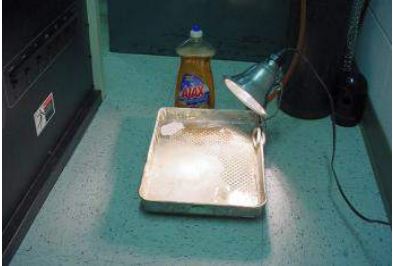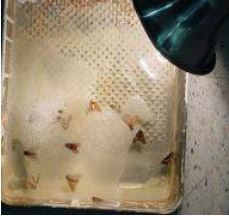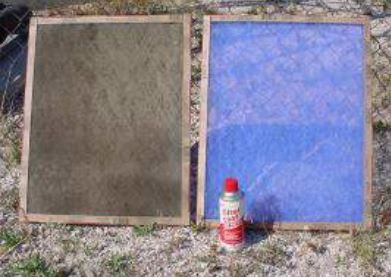Keeping Stuff Out of Your Transmitters

[November 2016] A clean transmitter room brings lots of benefits, including longer times between problems. However, there are two dangers to a clean transmitter – dust and unwanted animal visitors. As the seasons change, more visitors seek the available warmth. Gary Peterson offers some timely suggestions.
You can probably guess that I hate cleaning transmitters. Don’t you?
All of us experienced engineers can think of many other things that can be done with our time than removing dust and critters from transmitter cabinets. So, you can understand that I am always on the lookout for tricks to keep stuff out of the transmitters in the first place.
If you dislike spending your maintenance time cleaning dirt and dead bugs out of transmitters, the following tips may help make your life more pleasurable.
First Line of Defence
To get into your transmitter, “stuff” has to get into your building and then get past the air filters. That means properly sealing doors and all the other openings in the transmitter building is your first line of defense.
If your site is such that you may track in dirt or mud, etc, have a broom handy – or a shop vac, or something – to reduce the supply of materials that can be stirred up and become airborne, ultimately getting to the transmitter.
Of course, not only do you want/need to keep out the dirt, dust, and water, but you want to prevent uninvited guests from taking up residence in the building, or worse, inside the transmitter. Indeed, many engineers have anecdotes about the animals that gave their lives to prevent an All Bee Gees Weekend or Mungo Jerry Hit Marathons.
The invasions do become more common as the change to the fall and winter seasons tempts the many and diverse local creatures to seek out warmer and more hospitable residences for the winter. Even if they do not get into the transmitter, the squatters do tend to leave annoying reminders of their presence. So, all your efforts to keep them out in the first place will be rewarded with a great reduction in cleaning duty.
The Insect Barrier
It only takes a small space for critters to enter, so it is probably easiest to build a barrier with insects in mind – and the larger animals will also be blocked.
Carefully check the weather stripping on doors and windows from time to time. Change them when it seems they are not completely filling the space. Appropriate screens should be in place anywhere ventilation openings exist. To close off any entry points where conduits or coax come into the building use those cans of “instant foam.” They are great for closing such gaps as well as other openings, like along roof lines, etc.
The use of a good insecticide around the walls and openings will go a long way to reducing the number of critters in the building. I also like to use naphthalene mothballs to discourage both little and some not so little “tenants” from taking up residence.
Unfortunately, no matter what you do, some critters will find a way around it. For whatever reason, up here in South Dakota certain years and/or seasons seem to result in huge infestations of various insect species. In a bad year the “miller” moths can quickly clog a transmitter air filter. They even seem to be able to easily get into what is, for all practical purposes, a tight building.
A Flying Critter Trap
I actually came up with a “homebrew” solution that seems to work fairly well when the millers get real bad.
What I do is leave a pan of water on the floor, mixing in a bit of liquid dishwashing detergent to it – most any soapy material should work.
The only other thing needed is a trouble lamp to clamp to the pan.

The way it works is simple. When the rest of the transmitter room is dark, the moths are attracted to and circle the light attached to the pan.
Eventually, each of the critters will hit the water and the detergent will wet their wings. None of those critters will make it over to clog the air filter on the transmitter.

On my next trip to the transmitter site, all I had to do was dump the water-detergent mix with all the drowned moths and refill it with a fresh mixture. If you try this approach, just make sure that you use enough mixture to last without entirely evaporating before your next visit.
Helping the Filters Filter
However, no matter what you do, most sites cannot really achieve the “clean room” status that would make transmitter filters unnecessary.
Obviously, the more stuff your air filters catch, the less stuff you will have to deal with inside the transmitter cabinet.
Personally, I like to use disposable fiberglass filters and change them frequently – but do have a conversation with your transmitter’s manufacturer to make sure this will not create any problems with the air flow design of the unit.
Furthermore, it is possible to greatly increase the efficiency of your air filters. The trick is to use a good filter spray.
For some time, I have used RP brand “Filter Coat.” It comes in two forms. One is an oily liquid in a plastic spray bottle. After experimentation, we find that we prefer the oily material in the aerosol spray can.

Filter Coat is available at some hardware stores, and heating/ventilating and air conditioning shops also may carry it.
I would suggest you avoid the kind that smells like wintergreen. While it will make your transmitter shack smell like LifeSavers, I have found that it does not catch dirt very well.
Tips for Effective Filtering
Application of Filter Coat is quick and easy.
Just take a new air filter outside and lean it up against the perimeter fence. Shake the can well and apply a light coat to both sides of the filter before installing.
Be prepared: you will be amazed at how quickly the filter gets dirty. When I began doing this, I tried spraying the filter on only one of the two transmitters at our site. Within a few weeks the difference was obvious. Take a look:

The filter on the left is shown after three weeks in typical service way up here on the dry, dusty “Plains.” The filter on the right is a new filter.
Yes, you will have to change filters more often. But the important part, as you can see from the picture, is that the dirt does not end up inside the transmitter, where it adheres to all manner of irregular surfaces and, therefore, is much more difficult to remove.
I would encourage you to try a filter spray yourself. The next time you open up the equipment for maintenance, you will notice the difference, and smile.
These are just a couple of easily implemented ideas. Perhaps you have some other tricks that have worked at your site. If so, please share them with us.
After all, a clean transmitter is a happy transmitter!
– – –
Gary Peterson is “mostly retired” as the Engineering Manager for Schurz Communications, Inc. in South Dakota. When he is not playing with his grandsons, he can be contacted at: kzerocx@rap.midco.net
